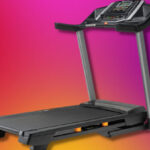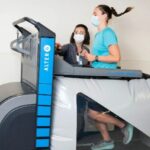Treadmills vs. Ellipticals vs. Bikes – How To Choose

In comparison to a stationary bike, the treadmill can help you burn 50 to 250 more calories per hour. Low-impact exercise will be provided by the elliptical and bike.
Ellipticals Vs. Treadmills Vs. Bikes
Treadmills – highest potential for improving bone density, weight loss, and cardiovascular health.
- Burn more calories than bike or elliptical
- Build maximum lower extremity bone density
- Customize workout with Decline / Incline features
- Minimal impact with SOFT deck technology
Elliptical Trainers – the advantages of weight-bearing exercise without the negative effects.
- Low impact workout that’s easy on body and joints
- Arm handles allow for a full body workout
- Lower perceived rate of exertion
- Burn fewer calories per hour than a treadmill
Exercise Bikes – High performance with minimal impact.
- Low-No impact workout easiest on body and joints
- Available in upright and recumbent, for virtually every performance level
- Most economically priced piece of equipment
- Lowest calorie burn / hour compared with a treadmill and elliptical
What Are Treadmills
The best way to increase lower extremity bone density and significantly raise overall muscle tone is through this well-liked weight-bearing exercise. The treadmill is superior to a stationary bike or an elliptical machine for a cardio and fat-burning workout because it can help you burn 50 to 250 more calories in an hour.
While exercise machines like exercise bikes and elliptical machines tend to put more stress on your bones and joints than running and walking do, the majority of high-end treadmills are built with surfaces that reduce impact and pounding. Compared to exercising outside on asphalt or concrete, this has a significant advantage.
The majority of treadmills also have electronic settings and features that let you tailor your workouts to your unique fitness requirements. Almost all models have incline and speed settings, and they can be programmed to meet specific calorie-burning, speed, and mileage targets.
Along with providing all the advantages of an outdoor walk or run (without the inconveniences of obstacles or the environment) in the comfort of your own home, the treadmill has emerged as the obvious training option for getting the best fitness results in the shortest amount of time.
What Are Ellipticals
The elliptical trainer provides a distinctive range of fitness advantages without placing undue strain on the knees, back, hips, or joints. It is a combination of a treadmill, stairmaster, and machine that simulates the pedal motion of an exercise bike. In addition to effectively increasing bone density, this weight-bearing exercise helps you burn calories more effectively than other types of exercise.
Arm handles and leg motion work the entire body and go beyond just working the lower body. In addition, the elliptical helps to create a lower “perceived rate of exertion” – you do more work and burn more calories while feeling like you’re producing less effort.
Additionally, you can typically use electronic settings to program this cross-training machine to your unique calorie-burning, speed, and distance objectives. One other unique advantage is that the elliptical can also be “pedaled” backwards in addition to forward, to effectively work a full range of leg muscles.
The elliptical has become popular among people who want to get the advantages of a full-body, weight-bearing workout without the strain and pounding.
What Are Exercise Bikes
Despite being around for a while, exercise bikes are once again at the forefront of the fitness industry. This is due in large part to advances in technology, improved designs and the immensely popular “spinning” programs that allow participants to simulate outdoor cycling in the comfort of their own homes or a group classroom setting.
Unlike other forms of “weight-bearing” exercise (such as running or walking), exercise bikes offer participants an opportunity to increase their heart rates without substantial stress on knees, ankles, feet or hips. Furthermore, built-in resistance features let you customize your workout to meet your unique goals by simulating hills, flat ground, and rolling terrain. Numerous models even have electronic features that let you set the bike up for a particular workout or goal. For achieving efficient, observable results, this is very beneficial.
Whether you’re a weekend warrior looking to work up a sweat or an experienced cyclist committed to perfecting your peddle stroke, stationary bikes are designed for practically every level of performance and body design. They are typically available in recumbent or upright designs.
True Fitness Technology, Inc. specializes in the manufacturing and distribution of premium quality cardiovascular and flexibility products. Users can look better, feel better, and play better thanks to TRUE’s cutting-edge and award-winning products, which are among the best in the fitness sector.

Calories Burned
With a staggering 466 calories burned in 30 minutes if you weigh 185 pounds, vigorous stationary biking is one of the gym’s most effective calorie-burning exercises according to Harvard Health Publications. While running or walking on a treadmill can surpass both of these numbers if you go quickly enough, an elliptical trainer workout generally burns 400 calories less in 30 minutes. Running steadily at 5.2 mph or vigorous cycling at 6 mph would be required to burn the same number of calories as an elliptical machine. The treadmill is therefore ideal for burning fat and losing weight.
Muscles Worked
Despite the fact that these exercise machines are primarily used for cardio workouts, they also develop muscle strength in addition to their cardiovascular advantages. The only machines that consistently provide a choice for an upper body workout are elliptical trainers, followed by bikes, treadmills, and ellipticals. By swinging your arms against resistance as you pedal, you can move the handlebars, working the muscles in your arms, back, and chest. Rarely will you come across a dual-action bike, which has handlebars that move as well. Otherwise, bikes work your glutes, quads, hip flexors, and hamstrings with little help from your calf muscles, whereas treadmills work your glutes, quads, hip flexors, hamstrings, and calves.
Features
Whether the equipment is designed for home use or is used in a gym, you can expect a fairly standard range of features on elliptical trainers, treadmills, and bikes. Push-button electronic resistance levels or speed adjustments, audio jacks for MP3 players, built-in console fans, adaptable or virtual reality exercise programs guided by personal trainers, and digital readouts that show essential data like calories burned, distance traveled, and speed are a few examples. Some even come with a heart rate monitor already installed to track how intense your workout is.
Impact
Low-impact exercises include both cycling and using an elliptical trainer. Low-impact exercises are those in which both feet remain on the ground or pedals at the same time, reducing the impact on your joints. If you have back issues, knee pain, or joint problems, these exercises can help. However, high-impact activities like jogging, sprinting, and walking are more advantageous for enhancing bone health than low-impact ones. A treadmill is therefore more efficient than a bike or an elliptical trainer if you’re looking for weight-bearing exercise equipment to combat osteoporosis.
Considerations
A low-end aerobic bike can be purchased for less than a low-end elliptical trainer or treadmill, out of the three machines. A well-built entry-level treadmill or elliptical trainer can be purchased for the same price as an exercise bike that is comparable to those found in gyms once you reach the $1,000 price point. In either case, including one in your fitness regimen may be very beneficial.
Which Cardio Equipment Increases Calorie Burn?
Everybody is curious to know the answer to this. Although it is an easy question to pose, it can be challenging to respond to. Let me gradually walk you through this. The outcomes are significantly more influenced by your efforts than by the equipment you are using.
Finding a machine where you can place the highest bids is necessary. The following query might be, “How will I know which machine that is?’ An experiment using various pieces of equipment will reveal the solution. The most accurate will be the one that is least taxing on your body, and you can work on it while still being in your comfort zone.
Your body will burn more fat the more you exert yourself. If a machine is difficult to use or causes your body pain or injury, you can’t expect yourself to put much effort into it. Consequently, what is the best choice varies from person to person.
Elliptical machines dominate when it comes to calorie burning, if we look at the market as a whole. It is the best cardio equipment for losing weight. The reason is that working out on your upper and lower body, which includes the majority of your body’s muscles, causes you to burn more calories. The elliptical therefore tops the list.
The lower body is the main focus of both stairmasters and treadmills. Elliptical machines are perfect for burning more calories. By using an elliptical machine for 30 minutes, you can burn your recommended 330 calories. Their minimal impact on joints accounts for the preference.
Your heart rate directly correlates to how quickly calories are burned. Your metabolic rate will increase as your heart rate does. If you want to see results, change up your workout routine on occasion. Try to vary your machine choices. A calorie counter display is found on the majority of the equipment. The findings are incorrect. They are merely estimates.
The elliptical should be your first option if you don’t suffer from knee, back, or other joint problems. A treadmill workout that includes regular intervals is also effective for burning calories.
Final Words
Use all three exercise machines, either during a single workout or on different days of the week, to avoid getting bored, suffering from repetitive stress injuries, or reaching a plateau from using the same muscles for the same exercises week after week. During one workout, spend 10 to 20 minutes on each machine; alternatively, switch machines every other session.
Tags: Bikes, Ellipticals, Treadmills, Treadmills vs. Ellipticals vs. Bikes








